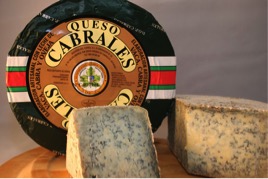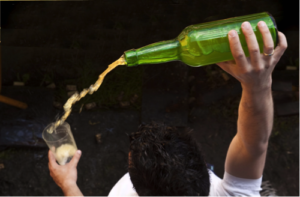
Asturias, one of Spain’s autonomous communities, is located in the northwest portion of the Iberian peninsula, bordered by Cantabria to the East, Castille and León to the South and the Bay of Biscay to the north. The region includes an extensive coastline, and several mountain ranges, most notably a large portion of the Picos de Europa. The consejo of Cabrales, located within the Picos de Europa, houses many limestone caves with perfect conditions—90 percent humidity and between 46-53 degrees Fahrenheit—to grow penicillium, a special fungus. This particular fungus is the special ingredient in Cabrales cheese, a strong blue cheese that, since 1981, has been protected by the status of Denominación de orígen, a classification system for Spanish products that regulates quality and geographical origin.

I love cabrales cheese, so I was beside myself with delight when I was able to visit the Cueva Exposición of the Fundación de Cabrales last Sunday during a trip to the region. For 4.50 we were treated to a 45 minute tour followed by cheese and cider tasting. Now, before you get too excited let’s be clear about what this tour really consisted of. This was no Napa Valley of cheese tasting. First, it was just two of us with the tour guide, who came out of some hidden second story to charge us for our tickets and then leave us to charge our phones and interact with some unfriendly cows until she appeared once again to open the locked cave door.

The tour consisted of her playing different sound affects (storm noises, pasture animal noises, etc.) with a remote control as she showed us different artifacts ranging from rocks, to farm tools, to the molds that cheese is kept in during the first stages of maturation, while it dries before being put into the caves. We were allowed to walk into a portion of the cave where there were replicas of wooden racks that cheese used to be stored on. The cave smelled strangely smelled like cheese in spite of no actual cabrales in sight, as visitors are not actually allowed into the part of the cave where cheese is that is being aged is stored because of risk of contamination.
After our little foray into the cave, I asked the tour guide about ten thousand questions, which she thankfully took in stride. First, I was surprised to find out that the different cheese producers share caves. Though the region is filled with caves with the right conditions for curing cabrales, there are only a limited amount of caves that have been equipped for the process. Our guide informed us, however, that there was a new cave that was being prepped for use. Next, she humored me by answering incessant questions about the regulations surrounding the Denominación de orígen classification. Apparently, when one buys cabrales cheese it must be wrapped in a special green wrapping or it is considered fraudulent. This cheese used to be wrapped in a special green leaf, but this led to too many worms, which were against health code (not surprising). She also let us know that the myth that cheese with worms tastes better (news to me) was not based on fact (whew).

During the final portion of the tour we were put into a room where a video played essentially repeating all of the information that we had just learned in the cave, but with more visuals. During this time the guide prepared some crackers and cheese for us to try. The sampling process was slightly uncomfortable as she was just kind of looking at us as we ate the twelve or so crackers on the bar between us. The both of us asked more questions to fill the silence. In moments that we did not ask questions she just looked as us as we chewed. At one point she offered us some cider, which we happily took, and then I asked her another string of questions about all of the rules about drinking cider in Asturias. Particularly, if you are served sidra it has to go through a process in which it is poured in such a manner that releases bubbles—the term for which is escanciar—into a cup that one is supposed to drink in one sip—a culín. If you don’t drink it this way, there is no carbonation and the flavors of the cider are supposedly off. The act of drinking cider is also highly collective—most of the time people just share one cup and clean the rim with whatever is leftover from the culín.

My trip to the Cabrales Cueva Exposición was the cheese pilgrimage I never knew I always wanted. I recommend it to lovers of the bizarre, the mountains, and, of course, strong moldy cheeses.
